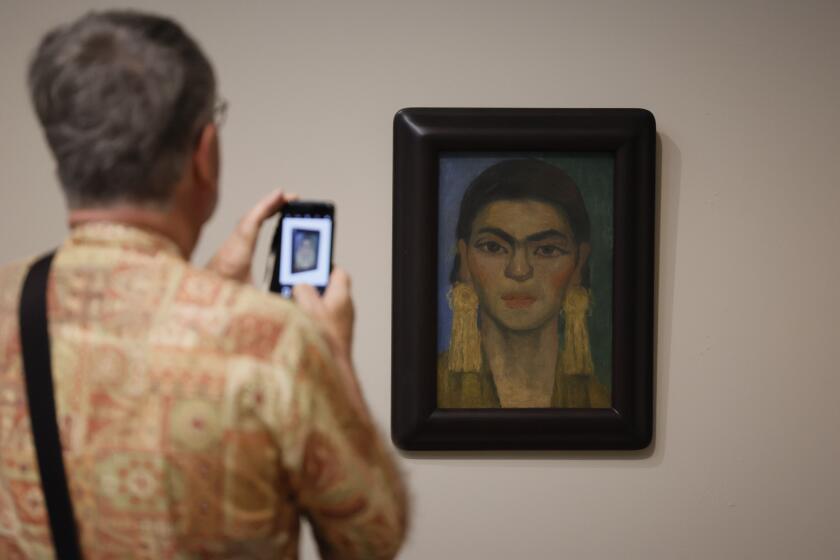Conceptually, It’s Not Exactly New
Gabriel Orozco’s art is less about making something new than about rearranging objects that already exist in the world. The results are akin to puzzles, which means a viewer’s experience of the work is limited to participation in the game.
This is Conceptual art in its Late Mannerist phase. At the Museum of Contemporary Art, where curator Alma Ruiz organized a big survey of Orozco’s work from the past 10 years that opened Sunday, gamesmanship introduces the show.
For the record:
12:00 a.m. June 10, 2000 For the Record
Los Angeles Times Saturday June 10, 2000 Home Edition Calendar Part F Page 2 Entertainment Desk 2 inches; 58 words Type of Material: Correction
Review content--In the June 7 review of the Gabriel Orozco survey at the Museum of Contemporary Art, the words “in artistic” were substituted for “inartistic.” The review should have read: “The first gallery is ringed with enlargements of newspaper photographs of athletes in action--soccer, cricket, rowing--inartistic photos that have been altered by a gridded overlay of colored circles and ellipses.”
The first gallery is ringed with enlargements of newspaper photographs of athletes in action at sporting events--soccer, cricket, rowing--in artistic photos that have been altered by a gridded overlay of colored circles and ellipses. The target-like patterns shift focus away from the whole and toward the parts, such as the balletic pose of an arm, the cant of a foot or the grimace of a face.
Centered in the room is a playing field made from two altered pingpong tables, which intersect in the configuration of an X. Where the tables cross, Orozco has inserted an artificial lily pond, filled with water and complete with blossoms.
What are the rules of play on this four-sided “Ping Pond Table”? It’s a pickup game, so you’re on your own. Museum visitors are, in fact, encouraged to play.
This genteel version of a rec room game is nowhere near as much energetic fun as the raucous public basketball court Jonathan Borofsky once set up inside a MOCA gallery. The Monet-like hazard in its center reads as a caution: Make up your own rules and enjoy the play, but beware the illusions of art.
It’s like your Mom warning you not to run out in the street after the ball. And who is Mom? Art as gamesmanship is, of course, the legacy established 40 years ago by the widespread embrace of Marcel Duchamp (1887-1968). His familiar precedent looms large in Orozco’s show.
It begins with those British sports photos. The circles and ellipses recall enlarged Ben Day dots from the mass-produced process of a newspaper, but they also echo the spinning patterns in Duchamp’s kinetic “Rotorreliefs.”
Duchamp’s signature chess board is also doubled in a piece called “Horses Running Endlessly,” which features a bigger than normal board with squares in four colors rather than two. Its herd of playing pieces is all horse-headed knights, which stampede in every direction.
Duchamp’s kinetic sculpture of a bicycle wheel is similarly multiplied in Orozco’s version, here becoming a tilted tower of eight wheels arrayed in a skewed grid. Like the multiplied chess board and doubled-up pingpong tables, the bicycle wheel assemblage might be thought of as Duchamp pushed into another dimension.
*
The most appealing aspect of Orozco’s art is precisely this doubling and redoubling of established precedent, which sometimes sends it spinning. His work represents a peculiar kind of artistic in-breeding, which is certainly appropriate for our slippery new world of virtual realities and scientific cloning.
Yet it’s also redolent of a certain artistic exhaustion. You can’t help looking at an Orozco and thinking, Duchamp again? The initial postwar revival of interest in the prewar Dada imp predates Orozco’s birth by a half-dozen years, and it was the foundation on which Conceptual art was built in the late 1960s. Thirty years on, the mutations that result from Orozco’s 1990s Duchampian in-breeding are erudite, clever and informed, but they don’t much make you want to look at them.
Perhaps that’s why the strongest work in the exhibition typically tends to be the slightest and least showy, while more elaborate amusements like “Ping Pond Table” feel precious, labored and overdone. One of the most memorable pieces is a simple 1992 photograph of two puddles on an otherwise dry asphalt pavement--a snapshot, really.
Something no longer present has run on the ground in circles between the two puddles, linking them through a series of wet lines. It’s as if, by going around in circles, this unseen actor has made a futile but determined attempt to draw out into the world the elusive reflections of sky, trees and clouds held tight within the puddles.
A fundamental yearning within art-making anchors this unassuming picture, which is titled “Extension of Reflection,” as does something fundamental about looking at art. Its charm and poignancies resonate.
More than likely it was a bicycle that performed the unseen drama of going-around-in-circles between the two pictured puddles. But far more effectively than in a truckload of sculptural chess boards and bicycle-wheel assemblages, Duchamp is here returned to the world of everyday experience. A powerful artistic precedent usefully absorbed is very different from the academic tyranny of citing sources, which can weigh down Orozco’s art.
The 38-year-old artist, born in Veracruz, Mexico, and now living mostly in New York, is often at his best with the throwaway casualness of ordinary photographs. Several pictures of specimen butterflies and Japanese philosopher’s stones, which look like they might have come from books, get deftly scissored. Orozco cut rings and circles in the photographs; like turning the dial on a radio or TV, he then gave the circles a simple twist. The signal jams.
Dull, pleasant, pragmatic order becomes jazzy, bumptious visual chaos--butterfly wings flapping in Rio and causing a tempest in New Orleans, so to speak. Orozco’s altered pictures shatter the anthropologically ideal bug and the philosophically perfect rock in which a clockwork universe is quietly being proposed. Things aren’t that way, these pictures say, even if we long for it to be so.
*
The bigger problem of Orozco’s art is most pronounced in 1993’s “La DS,” the work that first brought him widespread attention. Orozco took a classic 1950s Citroen automobile--the model name, DS, pronounced in French, sounds like the word for “goddess”--and sliced it lengthwise into three parts. The center section (about 2 feet wide) was removed, and the two outer sections were joined back together. The collapsed car was then carefully restored.
The best thing about the loopy, phallic, maniacal, squinteyed, two-person vehicle that resulted from this automotive plastic surgery is that Orozco made it into a classic lowrider--only sideways. The sleek vehicle already hugged the ground, so he compressed its space in the other direction instead. The excruciatingly refined, idealized sense of order shared by specimen butterflies, Japanese stones, Citroen’s DS and standard lowrider automobiles gets enthusiastically sliced to ribbons.
The worst thing about it is that it’s a Citroen DS--the officially sanctioned vehicle of linguistic Conceptualism. In a famous short essay 40 years before, the brilliant French critic Roland Barthes declared Citroen’s then-new DS the almost exact modern equivalent of the great Gothic cathedrals. It was, he wrote, “the supreme creation of an era, conceived with passion by unknown artists, and consumed in image if not in usage by a whole population which appropriates them as a purely magical object.”
In his art, Orozco seems to want to destabilize comfortable assumptions--and a lowrider, sideways, is a wonderfully perverse angle of approach. But quoting from Barthes to accomplish the task is like quoting from Scripture, or stamping the finished work across the forehead with the Good Conceptual Housekeeping seal of approval. Orozco ends up with a risk-free art, ready for immediate critical embrace, which is unlikely to destabilize much of anything.
The labor-intensive “La DS” was made just a year after “Extension of Reflection,” the unassuming snapshot of puddles in the street. Together they reaffirm something usually true about Conceptual art: the simpler the better.
The same goes for a show like this, which is way over the top. Gathering together 126 works by a young artist and publishing a big catalog with six essays analyzing a solo career that’s barely 7 years old does an artist few favors.
Like “Ping Pond Table,” the survey feels labored and overdone. Beware the illusions of the art museum.
*
* Museum of Contemporary Art, 250 S. Grand Ave., (213) 626-6222, through Sept. 3. Closed Monday.
More to Read
The biggest entertainment stories
Get our big stories about Hollywood, film, television, music, arts, culture and more right in your inbox as soon as they publish.
You may occasionally receive promotional content from the Los Angeles Times.







